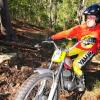| |
-
Corrosion inside the rims. Not usually visible from the outside but very common on this bike and if the spokes also need to be replaced, they are a very unusual Z design which can be a problem to find replacements for.
-
Post up a photo of what you have there
-
With the Alpina yokes, how do you go for mudguard and mudguard stay clearance to the exhaust and front downtube when the forks are fully compressed
-
-
The offset is very different on those Alpina/Pursang yokes so you would need to change both top and bottom yokes.
Using those Alpina/Pursang yokes increases the trail a lot so the steering feels very different. Some people like it that way some don't.
-
You will "progress" faster on the Beta but it sounds like you don't want to "progress" anyway.
Alexyz is right in that a TY175 or Fantic twinshock is a totally capable bike for novice/clubperson level competition and if you get a standard motor TY175, it is even easier to ride for a novice than a Beta 200 due to the gentleness of the standard TY175 motor response.
-
I read it as the $800 includes the spokes, rim refurb labour and wheel build labour. That sounds like normal commercial rates to me and a good reason to do it yourself
-
Yes but they may be on the opposite of the world
-
It's your bike. Do with it what you will.
-
-
If it's a contest for reliability without performing maintenance, I would vote for the 4RT.
If it's a contest for the bike that will let you ride in the most competitions, then I'd vote for whichever one has the best after-sales support where you live because riding in trials you are going to break things.
-
About 0.5mm side clearance cold for conrod to piston if the conrod is being held in position at its top end. If the conrod is being located from the bottom end, the side clearance at the conrod to piston connection can be greater
-
Most people fit preload spacers between the top end of the fork spring and the fork cap.
They work by pre-loading the spring so that the neutral position of the forks in their travel is right while you are riding. The more of those preload spacers you put in the forks, the higher the bike rides at the front.
-
Those hat shaped caps are spacers for adjusting the fork spring preload. Springs come in different lengths and those spacers allow you to set the bike up to have the right suspension sag. If the bike was being ridden without them, you may not need to adjust the preload. If you are fitting new springs you will probably need to adjust the preload.
-
Neither of those are oversize markings so if that's all there is on the crown, then it is likely to be on the standard bore.
The safest bet is to have whoever is going to rebore the cylinder measure the bore to advise what the minimum size piston kit is you should get.
-
I know I've got a spare TY250A lever that is undamaged but like I said, I'm further than Guy so the postage would be expensive.
I just looked on eBay and there's one advertised for sale in the US for US$22. There's no way I would sell mine that cheap
-
I'm still here. What is it you are after?
-
https://www.yamahaty.com/english/ty125en/elec125en.html
-
Lorenzo answered about the sleeve gear type that has the sintered bronze bushes. Sounds like that's what you've got
-
Inspect the gearbox output shaft. It is a short shaft that will have either a pair of sintered bronze bushes or a pair of needle roller bearings inside where it runs on the main gearbox shaft. Both types can wear/fail and cause consequential damage to the gearbox gears due to misalignment (breaks teeth off). Wear in the sintered bush type is very common. Both the shaft surface and the bushes might be worn. I haven't seen a needle roller type fail but it would probably be more spectacular.
Check that the kickstart return stop is not bent or burred and has a nice action. This is a fairly common failure point.
Also there is supposed to be an aluminium washer on the end of the kickstart shaft. This may be worn out or missing.
-
https://newellmotorcycles.com.au/pages/bultaco-history
your frame is a model 150 and your motor is a model 80.
Open the link and you will find the years for your frame and motor
-
It's quite normal for people to ride twinshock bikes in events that don't have a twinshock class
-
Every second-hand Bultaco I have ever bought has needed to have the crankshaft bearings replaced. They don't last long. There are a few other things inside the motor that may well also need attention.
I suggest you use someone who has a good reputation for rebuilding Bultaco motors. There are design quirks that catch people out on their first Bultaco motor rebuild.
-
My 138 Alpina is the model that followed the 116 and it has a standard-bore 370 Pursang piston in it whatever diameter that is. I don't remember what stamping the cylinder had.
-
When fully assembled and with the motor stopped, the main gearbox shaft usually needs to be wiggled (by rocking the bike) to allow it to change gears.
It looks like you have taken the clutch off. This usually allows the shaft (and the gears on it) to move axially out of their ideal positions, making gear changing harder. The clutch nut holds the shaft in the correct spot.
|
|


